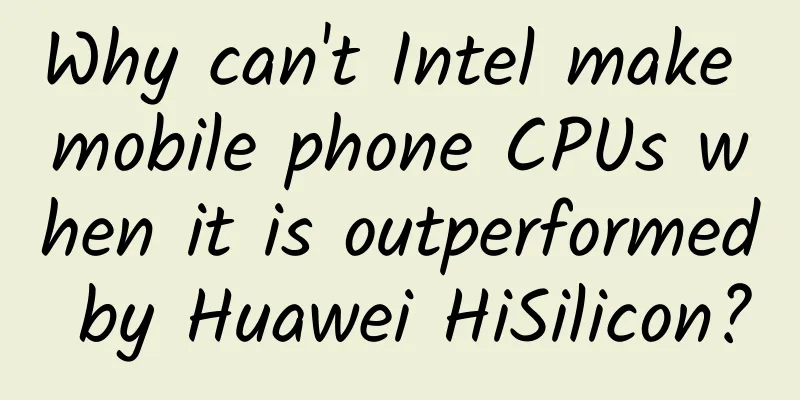Why can't Intel make mobile phone CPUs when it is outperformed by Huawei HiSilicon?

|
In response to Intel's sluggish performance in the mobile (e.g. smartphone) market, some industry insiders suggest that Intel should look for a heavyweight partner in the smartphone market, such as Huawei, which is gaining momentum in the smartphone market this year, and believe that the two sides can complement each other's strengths. Is this really the case? What is the reason why Intel has been unable to break through in the mobile market? Is it just the lack of a heavyweight partner? First of all, the so-called complementary advantages of Intel and Huawei's cooperation, as mentioned by industry insiders, is that Huawei can use Intel's chip architecture design capabilities to enhance the competitiveness of Huawei HiSilicon chips, but we believe that this possibility is almost non-existent. First of all, from Intel's overall strategy, it hopes to dominate the world from servers, PCs to mobile (smartphones and tablets) and future wearable devices with its own x86 architecture ; secondly, Intel's so-called chip design capability advantage is still based on its own x86 architecture. If Intel can help Huawei become the best chip among ARM architecture chip manufacturers, then why doesn't Intel buy ARM's IP like other manufacturers (such as Qualcomm, Samsung, MediaTek, etc.) to develop its own chips based on ARM architecture and compete directly with chip manufacturers such as Qualcomm and MediaTek in the open market? This is a paradox in itself. Secondly, for mobile chips, in addition to AP (application processor), the integration capability of baseband chips and SoC is also crucial . However, Intel does not have an advantage over chip manufacturers in the ARM camp (including Huawei) in the above aspects, and has even fallen behind. The industry knows that the biggest selling point of Intel when it first entered the mobile market was performance, but due to the rapid development of ARM and its camp in technology, especially the self-developed chips represented by Apple, Intel's original performance selling point has been greatly diluted today . This can be seen from the recent comparative test of the mainstream SoC chips of Samsung, Qualcomm and Intel (Qualcomm's Snapdragon 810, Samsung's Exynos 7420, Intel's Atom Z3580) by the technology website Android Authority. Intel chips are at the bottom in terms of main performance, battery life, and actual use items. The reason is that Android Authority believes that Intel's biggest problem is that mobile chips use the same architecture as desktop PC chips, and making high-performance, energy-saving processors is a very complicated task. ARM's advantage in this field is very obvious . For Intel, it is basically hopeless to surpass ARM. From this point of view, Intel's ability to design the architecture of mobile chips is obviously inferior to that of chip manufacturers in the ARM camp. In this case, it also proves the aforementioned paradox that Intel can help Huawei design the best ARM chip. Of course, this includes both AP and SoC integration capabilities. Looking at the important baseband chip, since Intel acquired the baseband chip manufacturer Infineon and its previous Apple customers were snatched away by Qualcomm, its performance in the baseband chip market has been tepid. The latest statistics show that Intel's baseband chip market share ranks behind Qualcomm and MediaTek, accounting for only 4.6% of the market share, which is only 1.3 percentage points higher than Huawei HiSilicon . But you have to know that HiSilicon is only self-sufficient, and Intel is facing the open market. The important thing is that in terms of the technical level of baseband chip development, Intel does not have a leading advantage compared to HiSilicon . For example, the XMM 7360, which will be launched next year, is compared with the HiSilicon Balong 750. The Balong 750 supports LTE Cat.12 DL and Cat.13 UL, and the DL MIMO is up to transmission mode 9, which is comparable to the baseband chip performance of Qualcomm's flagship Snapdragon 820 next year. In contrast, the XMM 7360 only supports Cat.10 DL and Cat.7 UL. With the shipment of Qualcomm's next-generation Snapdragon X16 with a maximum downlink transmission speed of up to 1Gbps per second in mid-2016, Intel will once again lose its appeal to OEM manufacturers in terms of baseband chips. In fact, not to mention the X16 next year, even the X12 released not long ago is much higher than the XMM 7360 in terms of manufacturing process, function and performance. Of course, we are not completely denying the competitiveness of Intel's baseband chips here, but the technical level is far from the top level in the industry. In this case, what can Huawei learn from and complement with its cooperation? How can it compete with Qualcomm? In fact, in the competition of the smartphone industry, the top three manufacturers (Samsung, Apple, and Huawei) that can cause changes in the industry structure have all possessed the ability to design independent chips based on the ARM architecture, and have been proven to be quite competitive in the market. Under this background, no one can change their mind and learn from or adopt Intel's x86 architecture . Moreover, given the above-mentioned Intel's technology and performance in the mobile chip market, let alone taking advantage of and complementing each other, it is a good thing not to drag their feet. As for other manufacturers, it is also difficult to support Intel's x86 architecture chips on a large scale due to the same reason. For example, the SoFIA 3G chip released by Intel this year has not achieved significant results even for the low-end market. As for independent baseband chips, there is only one new product, XMM 7260. Although it has been shipped for a long time, there are very few customers except for Asus' ZenFone 2 and Microsoft's Surface 3. In summary, we believe that the main reason why Intel has been unable to break through in the mobile market is the gap in its own technology, not because of not cooperating with heavyweight partners such as Huawei . As we analyzed earlier, their current mobile chips are better than Intel's, so why should they cooperate with Intel? What is the basis for cooperation (mutual benefit)? As the old saying goes: A phoenix attracts a phoenix. If Intel becomes truly strong in the mobile chip market one day, why would it worry about not having the support of its partners? As a winner of Toutiao's Qingyun Plan and Baijiahao's Bai+ Plan, the 2019 Baidu Digital Author of the Year, the Baijiahao's Most Popular Author in the Technology Field, the 2019 Sogou Technology and Culture Author, and the 2021 Baijiahao Quarterly Influential Creator, he has won many awards, including the 2013 Sohu Best Industry Media Person, the 2015 China New Media Entrepreneurship Competition Beijing Third Place, the 2015 Guangmang Experience Award, the 2015 China New Media Entrepreneurship Competition Finals Third Place, and the 2018 Baidu Dynamic Annual Powerful Celebrity. |
<<: What can you do to save your contract phone that may be phased out?
Recommend
User Operation: AARRR Model for Products from Zero to 200,000 Users
Without further ado, the full article is structur...
Is the franchise fee of Yulin Ticketing Mini Program high? Yulin Ticketing Mini Program Franchise Fees and Process
How much does it cost to join the Yulin Ticketing...
[Smart Farmers] Don’t worry, foodies! This “exotic fish” can survive in saline-alkali land
Editor’s Note: Protecting biodiversity and ensuri...
iOS 9 multitasking split screen tips
iOS 9 Multitasking Overview The most eye-catching...
Where is Google heading as its PC search business growth stalls?
Google 's financials have remained largely th...
Apollo Robotaxi landed in Guangzhou, Baidu's number of cities in which autonomous driving is being trialed ranks first in China
On July 17, Baidu Apollo Robotaxi was officially ...
How to play the lottery (how to get started for lottery novices)
Some people hear or see others winning the lotter...
Please restrain yourself from playing mini games on WeChat Moments
In WeChat Moments, screen-sweeping incidents caus...
The latest news on delayed retirement: the plan will be officially implemented in 2022! Attached is a list of retirement ages for those born after 1970!
We know that one important reason for implementin...
Does aerospace also need energy conservation and emission reduction? Unveiling the "green revolution" of rockets
In recent years, the number of global launch vehi...
Don't sit for too long, this position will sink! 2 ways to improve it → (with illustrations)
Every time I see someone's peach buttocks, I ...
Vodafone launches Smart Tab III tablet Lenovo becomes an unknown helper
[September 9 news] At the IFA exhibition, the famo...
The official account's ten-minute stock trading video course
Introduction to the resources of the public accou...
In order to let aliens understand the earth's information, they desperately came up with these "garbled codes"
Recently, the U.S. Congress held a public hearing...









